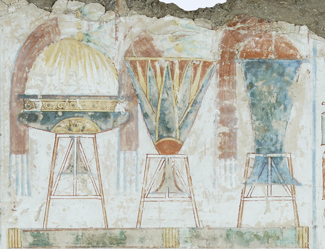9.3 The lack of shadows
A corollary of this point bears upon a feature of Egyptian art that we have already noted: colour, and the transition from light to dark. In the spectator-oriented system of perspectival representation, the most fundamental move is to establish the spatial armature into which bodies can be placed. This is achieved through the device of the vanishing point with its accompanying orthogonals: that is, lines that appear on the flat surface as diagonals, but represent surfaces or edges set at 90 degrees to the picture plane – for example, the roof line of a building disappearing into the distance.
The next most important thing, however, is to establish the illusion of those bodies occupying the picture space themselves. This is achieved through ‘shading’. Shading is the transition from light to dark that mimics in two dimensions the way light falls on an object in three dimensional space – for example, a ball. Establishing this illusion of three-dimensionality is a cornerstone of the perspectival system. It is completely absent from Egyptian painting (Figure 31). In this system, far from conveying ‘believability’ shading would suggest the accidental, partial nature of the single viewpoint instead of what is actually being prioritised, namely an ‘objective’ representation of the thing as it really is, colour included. Egyptian painting knows no shadows.

